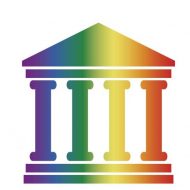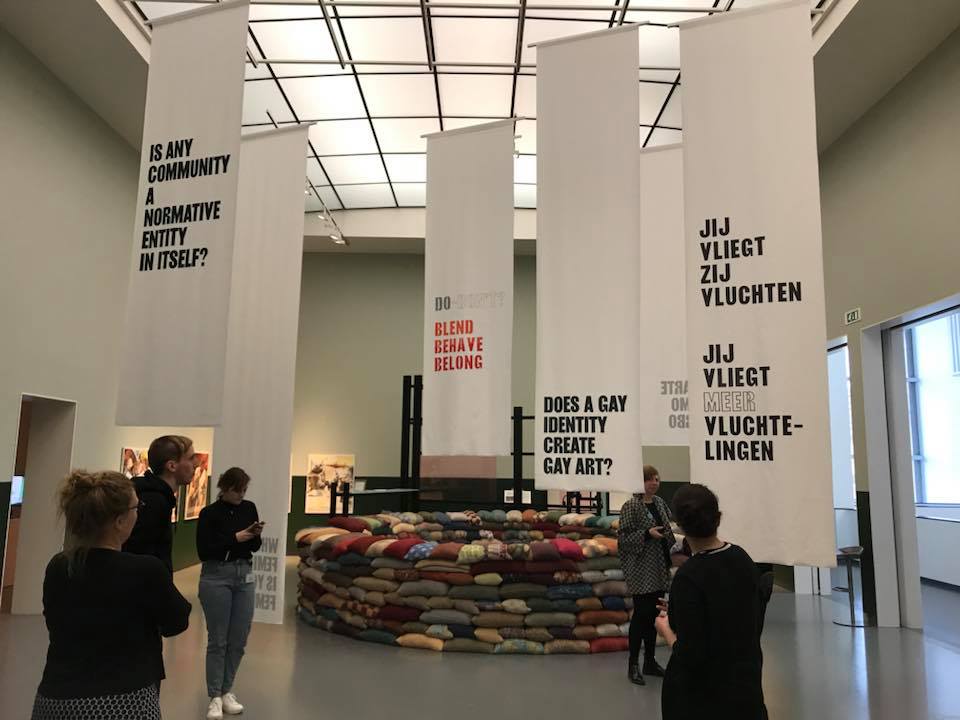Participants: Daniel Neugebauer (DN – Van Abbe Museum), Marleen Hartjes (MH – Van Abbe Museum / Studio-i), Celeste * (C – intern MH), Machteld Jurriaans (MJ – City Archives A’dam / IHLIA), Danielle Kuijten (DK – Imagine IC), Hannah Oosterhout (HO – Reinwardt student / Fries Museum Leeuwarden), Mirjam Sneeuwloper (MS – Amsterdam Museum), Olle Lundin (OL – Van Abbe Museum), Geralda Jurriaans (GJ - Allard Pierson Museum), Sam * (S – Reinwardt student), Henri Sandront (HS – Stedelijk Museum), Lonneke van de Hoonaard (LH – IHLIA), Anne * (A – Master Gender Studies), Alice Venir (AV – Queer Residency Project), Charles Esche (CE – Van Abbe Museum). Report: M. Jurriaans, on the basis of the minutes by K. Schram
Introduction
The meeting at the Van Abbe Museum on the 14th of March 2018, was called into life to establish continuity for the network and to not lose momentum. In the previous network-meeting (Tropenmuseum, 17/11/2017), the participants spoke about visions and goals for the network. Now the same visions and goals needed to be pinpointed and turned into a sustainable reality.
Our host was the Van Abbe Museum (VAM) with Daniel Neugebauer as moderator. Unfortunately, this was also DN’s farewell-meeting since he was hitched by Berlin.
DN gave us a warm welcome and an introduction to the current visions of the VAM. Their director, CE, has encouraged the museum-employees to actively engage in the field of queering. Decolonization of museum-practices is also one of the priorities of the museum for 2018-2020. The museum is challenged into being deviant, using the term deviant in the broadest sense including both mental and physical deviancies of visitors, employees, practices and research. The staff has responded in great enthusiastic manners to this challenge. DN’s ended his introduction with giving thanks to the Queering the Collections network and emphasizing the importance of this network, by giving examples of current LGBTI-violence in the news (the hatred against the Suit Supply campaign and the killing of Orlando Boldewijn).
The meeting was continued by a quick introduction-round of all the participants. In this round the participants told the others quickly either what they are doing already, are planning on doing, or explicitly are not doing around queering.
MH spoke about Studio-I: a platform for an inclusive culture within museums where the know-how is shared. DK works on filling gaps in collections and archives. She also noted that an exhibition is not an end-destination, but rather a starting point to collect more. MS started with queering, without naming it so, back in 2013/2014. She investigates ways to give a proper representation of all communities at the Amsterdam Museum. OL is the coordinator Queer Constituency at the VAM and fights both with as against the museum. GJ expressed how the APM is currently not invested with queering and she is looking for ways to introduce the museum to a more inclusive vision. HS organizes public events for the SM from a LGBTQI angle.
LH, director of IHLIA, spoke only later about her plans around the 40th jubilee of IHLIA and CE, director of VAM, expressed his feelings on how we are all partially queer and in some way part of a minority. He spoke about that we need to remind ourselves that queering is not a vast concept and that we consistently need to construct, deconstruct and reconstruct our ideas on queering and inclusiveness. Next to the work field professionals, there were enthusiastic students and interns present that all have a focus on the research and theoretical framework of queering.
Continuity
Tour
MJ gave a short recap of last meeting where there was a lot of talking about plans, but nothing became really concrete yet. The network needs leadership, someone that pulls it all together and makes sure the network doesn’t lose momentum. However, who has time to take up that role? For now, it looks like we will all carry the load partially.
At the last meeting the participants spoke about expanding outside of Amsterdam and to become more intersectional. If museums need to be inclusive in an active manner, so does the network. The first step outside of the Amsterdam-bubble was the visit to the VAM, and the start of the ‘tour du QtC network’.
To keep this going, MJ asked for three future locations for the next nine months. DK invited us all to come mid-June to IIC, when they will have opened a new exhibition on resistance in Amsterdam Zuidoost. HS followed with an invitation for in October. MS wanted to know dates, so she could plan a network-outing to a different city, as a third location for December/January. MJ will keep in touch, to see if per network-meeting certain themes should be discussed.
Agenda
1. Imagine IC – Mid June
2. Stedelijk Museum – End of September/beginning of October
3. Organized by Amsterdam Museum on a different location – December 2018/January 2019
Toolkit
MJ continued the conversation with bringing up the toolkit, as proposed during the previous meeting. Our network is about sharing knowledge, finding inspiration, collecting what institutions do around queering and finding out why institutions are not interested in queering and how to change that.
In the previous meeting Riemer Knoop opted for a Queering Toolkit. We know there is a major blind spot at both large and small institutions/museums. How can we challenge that? And if we want to bring a Queering Toolkit to life; what should this include? It is clear that museums need something physical to work with, like a reader, a game, a booklet or a workshop.
Currently, multiple people are brainstorming separately from each other on toolkits and frameworks. These researches need to be brought together, to see what toolkit might work the best for QtC. Also, it was noted that lots of Reinwardt students are researching queering, however all separately from one another which is perhaps something that needs to change. Internationally, there are lots of researches and projects/processes around queering that needs to be collected.
A workgroup, formed out of professionals and students, should come together to make an inventory of all the current research around toolkits and to then distill to a few options. Next to that, the participants were all asked to pitch ideas for toolkits and send it to KS.
Workgroup
1. Kevin Schram
2. Machteld Jurriaans
3. Rose Loogman (intern IHLIA)
4. Marleen Hartjes
5. Sam * (Reinwardt student)
To do
Email Kevin Schram, queering@ihlia.nl, with ideas/pitches/inventories for the Toolkit.
MH suggested that Studio-I could work as a resource for QtC, since they collect best practices from museums around inclusiveness. Queering processes will also be collected, and museums can present their projects and processes.
Expanding the network
To move outside of the Amsterdam Bubble and to become more intersectional, the participants are all asked to invite a ‘museum-buddy’ to the next meeting from a museum, preferably outside of Amsterdam.
Another thing that was noted, was that the current participants were happy with these meetings to find out what everyone is doing around this topic. Someone needs to take initiative to collect these processes, also when we are not meeting one another. These could be collected for Studio-I but also for IHLIA. With showing what kind of processes exist at the ‘competitors’, the network will also stand stronger when inviting new museums to the network.
A first step for new museums to the network, LH stated, would be for them to create a series of events around Pride. However, to represent the complete society should be an all around the year obligation, and not during a time when it is an ‘hot topic’. Also, as Wayne Modest in the previous meeting stated, the network should possibly expand their vision on queering by including to ‘rethink the concept of gender’. This could perhaps appeal to new institutions as well.
To do
Bring a buddy
Presentations
LH gave a short talk about the 40th jubilee of IHLIA and her vision to have an exhibition mid October 2018 at the ObA. The exhibition will also travel outside of Amsterdam at different archives and libraries within the country. IHLIA wants to critically reflect on their own history of activism and research the movement, knowing very well LGBTQI activism has not been and is not always intersectional.
IHLIA is also looking for partners for collecting stories and objects for the exhibition. For this they are also teaming up with Imagine IC.
AV spoke about the Artist in Residency/Queer Residency, made possible by a donation from the Vrienden en Vriendinnen van de Schorerstichting, where they hope to include three artists that connect or are from the trans* and intersex communities. Research points will be ‘why am I here?’, ‘what is my relation to the collection’, ‘who benefits by my presence?’. The works will be presented in September, together with a conference.
OL and DN spoke about the Queer Reading Group and how queer-themes are discussed within the museums and how it then is shaped into the collection presentation. They took us to collection where questions were pitched to re-shape the way you look at collections and the way you look at your own ideas.
Recap to do list
1. Mark the dates (when they are released) for the upcoming QtC meetings.
2. Bring a buddy to these meetings.
3. Email your ideas/sources around museums toolkits, specifically around LGBTQI to queering@ihlia.nl

